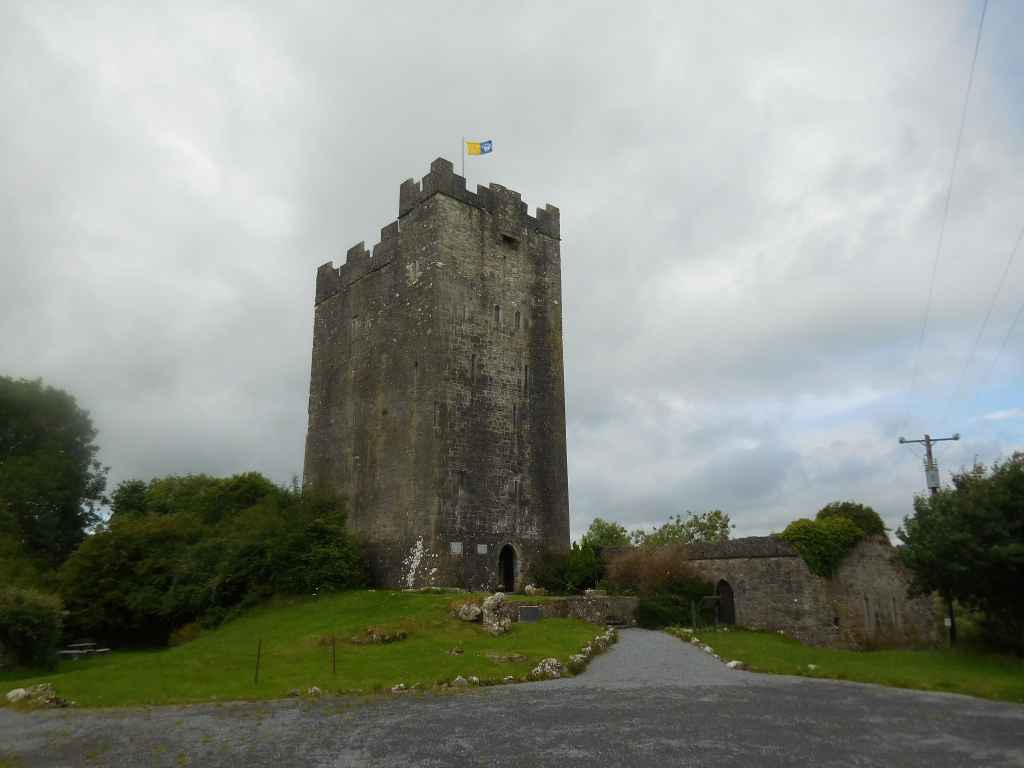Dysert O'Dea
Burg / Castle
Der keltische Clan der O'Dea (Ó Deághaidh) beherrschte diesen Teil von Clare schon seit vorchristlicher Zeit. Der Zusatz Dysert (Disert - Eremitage) geht auf den Mönch Tóla (8. Jahrhundert) zurück, der auf dem Besitz der O'Dea ein Kloster gründete. Der Clan verteidigte sein Land gegen feindliche Clans, die Wikinger und später der Anglo-Normannen. Und wenn gerade keine externe Bedrohung vorlag, bekriegten sich die Mitglieder untereinander.
1315 begann der schottische Clan der Bruce eine Invasion in Irland als Teil des Unabhängigkeitskriegs von Schottland gegen England (die Invasion endete mit dem Tod von Edward Bruce). Die Anglo-Normannen nutzen die Gelegenheit und versuchten mit einem ihnen ergebenen Teil der Clans O'Dea das Königreich von Thomond einzunehmen, das ihnen bisher widerstanden hatte. Am 10. Mai 1318 griffen de Anglo-Normannen unter Richard de Clare die Feste von O'Dea an, wurden aber von Conor O'Dea in eine Falle gelockt und mit Hilfe der Clans der O'Connor und der O'Brien konnte Conor den Truppen de Clares eine vernichtende Niederlage bereiten. Das Königreich von Thomond blieb danach bis 1570 frei von Fremdherrschaft.
Die heutige Burg wurde um 1480 von Diarmuid O'Dea erbaut. Die Truppen Cromwells beschädigt das Gebäude 1651 schwer. Nach dem Krieg der zwei Könige (zwischen Wilhelm von Oranien und Jakob II, 1689 - 1691) verloren die O'Dea (die Jakob II unterstützt hatten) ihre Besitztümer. Die Burg ging an die Familie Synge über, die sie verfallen ließ. In der zweiten Hälfte des 20. Jahrhunderts wurde die Ruine von John und Anola O'Day aus Wisconsin gekauft und wieder instand gesetzt. Seit 1986 ist die Burg für Besucher zugänglich. Gegen ein paar Euro Wegegeld wird uns auf vier Stockwerken ein informativer Einblick in die Höhen und Tiefen der Clangeschichte gewährt.
The Celtic clan of O'Dea (Ó Deághaidh) had been ruling this part of Clare since pre-Christian times. The addition Dysert (Disert - hermitage) goes back to the monk Tóla (8th century), who founded a monastery on the property of the O'Dea. The clan defended their land against hostile clans, the Vikings and the Anglo-Normans. And when there was no external threat at the moment, the clan members waged war against each other.
In 1315 the Scottish Clan of Bruce started an invasion of Ireland as part of the independence wars of Scotland against England (the invasion ended with the death of Edward Bruce). The Anglo-Normans used the opportunity and together with a part of the Clan O'Dea that was loyal to them tried to conquer the Kingdom of Thomond that had resisted them so far. On May 10th, 1318 the Anglo-Normans led by Richard de Clare attacked the stronghold of the O'Dea but were lured into a trap by Conor O'Dea and with the help of the Clans O'Connor and O'Brien Conor delivered a devastating defeat upon the troops of de Clare. Afterwards, the Kingdom of Thomond was free of foreign rule until 1570.
The current castle was built around 1480 by Diarmuid O'Dea. In 1651 the troops of Cromwell damaged the building severly. After the Williamite War (between William of Orange and James II, 1689 - 1691) the O'Deas (who had supported James II.) lost their possessions. The castle passed on to the family Synge, who left it to decay. In the second half of the 20th century, the ruin was bought and restored by John and Anola O'Day of Wisconsin. Since 1986 the castle is open to the public. For a few euros of toll fee we are granted an informative insight into the ups and downs of the clan history on four levels.
Dysert O'Dea im Detail / Expand on Dysert O'Dea
Zugeordnete Themen / Assigned Topics:
Mehr Informationen über - Dysert O'Dea / More information about - Dysert O'Dea
Lage / Location
- Irish grid: R 28310 85015
Historischer Verweis / Historic Reference
(© Wiki Commons)
- BC
- Ballycasheen Ganggrab / Ballycasheen Portal Tomb
- BG
- Ballygriffy Burg / Ballygriffy Castle
- BL
- Ballyganner Süd Keildolmen / Ballyganner South Wedge Tomb
- BP
- Ballyportry Burg / Ballyportry Castle
- BY
- Ballyshanny Ringfort
- CA
- Clare Abbey
- CF
- Corofin
- CG
- Cahergrillaun Dolmen / Cahergrillaun Tomb
- CM
- Cahercommaun Ringfort
- CN
- Carran Kirche / Carran Church
- CP
- Caheraphuca Keildolmen / Caheraphuca Wedge Tomb
- CT
- Castletown Burg / Castletown Castle
- CV
- Creevagh Keildolmen / Creevagh Wedge Tomb
- CW
- Caherminnaun West Dolmen / Caherminnaun West Megalithic Tomb
- DR
- Drumcliff
- EN
- Ennis
- IL
- Inchiquin Lough
- KA
- Killone Abtei - nicht / Killone Abbey - not
- KB
- Killinaboy
- KF
- Kilfenora
- LM
- Leamaneh Burg / Leamaneh Castle
- NV
- Noughaval
- PN
- Parknabinnia Keilgrab / Parknabinnia Wedge Tomb
- RT
- Rath Kirche / Rath Church
- RU
- Ruan
- TE
- Temple Cronan Church








